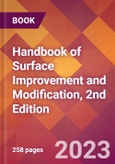This book covers the comprehensive study of surface improvement and modification, including the introduction of a range of processing methods such as physical, chemical, and electrochemical treatments. The fundamentals of theory, design and application are thoroughly discussed. It offers an authoritative view on surface improvement technology to both researchers and practitioners in various industry fields.
Surface appearance is one of the most important properties of many products. It must be tailored to the product needs, which are frequently very different in various applications.
This book is devoted to additives used for surface modification of materials a technology used in the production and processing of adhesives, appliances, automotive, bookbinding, building and construction, business machines, caulks, cellular phones, coatings, concrete, dental applications, electronics, flooring, footwear, furniture, graphic arts, hot-melt adhesives, hygiene, labels, lacquers, leather, lithographic inks, medicine, nanofluids, nonwovens, optical films, packaging, paints, paper, plastics, pressure-sensitive adhesives, printing inks, rubber, sealants, sporting goods, tapes, varnish, wire and cable, wood and many other materials. This book is the first known published book on this subject. The second edition brings, in addition to the verified content of the first edition, the discussion of the most recent findings and achievements in the field.
Handbook of Surface Improvement and Modification contains information on eleven groups of additives that are commercially available for the improvement and surface modification of manufactured materials. These include additives improving scratch and mar resistance, gloss, surface flattening, tack reduction, tack increase (tackifiers), surface tension reduction and wetting, surface cleaning, dirt pickup resistance, hydrophobization, anti-cratering, and leveling, and coefficient of static friction. They are discussed in separate chapters in the same order as above.
The highlights for each chapter are as follows:
- Scratch and mar resistance: many important influences combined form mechanism of protection; scratch features (ironing, transition, stick-slip, tearing) determination; texture patterning and scratch visibility; self-healing; damage observation on nanoscale; violet laser scanning confocal microscope cross-section profile of scratch damage; silsesquioxanes
- Gloss enhancement: magnetic resonance imaging measurements of human brain reactions; instrumental measurements; meso- and micro-scale roughness; hyperbranched resins; durability of gloss
- Surface matting: powder coatings; roughness formation; dull black coatings; curing rate and flattening; low-gloss soft-touch; anti-glare coatings
- Tack-free: abhesion features; instrumental surface tack measurement; surface tension; nature-inspired; completeness of cure; dental applications
- Tackifiers: balance of elastic and viscous properties; structure and origin of rosins; phase structure of tackifying system; compatibility; environmental solutions; pharmaceutical, cosmetics, and medical applications
- Surface tension and wetting: bottlebrush polymers; rigid-rod polymeric fiber; superhydrophobicity; superhydrophilicity; surface tension prediction; porosity and morphology; wettability surface gradient; surface free energy; bacterial adhesion; photo-induced hydrophilicity; orthopedic implants; high-speed printing; dry-erase inks
- Surface cleaning and stain inhibition: in-source cleaner regeneration; the negative impact of perfluorinated acids; bio-inspired cleaning methods; hole generation and pollutant decomposition; photocatalytic self-cleaning; anti-graffiti coating, graffiti removal
- Dirt pickup resistance: HDPE and carnauba waxes; mark and scuff resistance; decorative paints, wood stains, leather lacquers
- Water-repelling: biomimetic solutions; superhydrophobic coatings; self-hydrophobization; superamphiphobic surfaces; chemical functionalization, microtextured surface; building structure protection; protection against ice formation
- Anti-cratering and leveling: thixotropic behavior; nanoparticles; leveling agents; superplasticizers; powder coatings; sag-leveling balance; pinhole prevention
- Coefficient of friction: tribometers; speed effect; dwell time effect; surface patterns and textured surfaces; elemental mapping; capillary bridge; human skin; dangling bonds; polymer brushes; lamellar tribofilm; microspheres, release agents; a film with a consistent coefficient of friction
Table of Contents
1 Introduction








